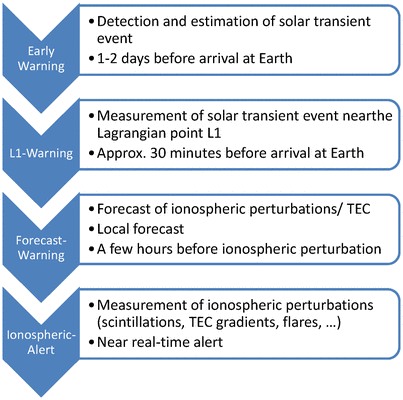Test Ionospheric Warning GNSS
Info
Ionospheric Warning System
Threats for communication and navigation systems (e.g. GNSS applications and HF communication) often originate in ionospheric disturbances. Accurately timed warnings can help essentially to mitigate them. The currently developed Ionospheric Warning System is a multi-level warning system (c.f. Figure) with warnings ranging from long term predictions to real-time alerts. The warning messages are distributed on this website and additionally via Email to the user community. Interested users can subscribe to the eMail-service.

Early Warning Message for GNSS users
The first level warning, the Early Warning Message for GNSS users is fully operational. It has been developed within the EU FP7- project AFFECTS (Advanced Forecast For Ensuring Communication Through Space). The Early Warning for GNSS users is based on predictions of geoeffective solar transient events (e.g. PRESTO message). It is distributed about one to two days before the potential arrival of a solar event(e.g. coronal mass ejection) at Earth. The warning message comprises information on the expected arrival time at Earth, rough predictions of the geomagnetic activity, the uncertainty of the arrival time and the event probability.
L1-Warning Message
The second level will be called L1-Warning Message, named after the Earth- Sun liberation point (Lagrangian point L1), where satellites are orbiting at about 1.5 million kilometers from Earth, in the direct line between Sun and Earth. The Advanced Composition Explorer (ACE) satellite for example measures next to others solar wind and Interplanetary Magnetic Field (IMF) parameters which enable to estimate the arriving solar transient event approximately 30 minutes before arrival at Earth (dependent on solar wind speed). Good geomagnetic activity forecasts (kp index and Dst index) up to 3 hours ahead, derived form ACE measurements, as well as first and rough approximations of the ionospheric disturbances are distributed in the L1-Warning Message.
Forecast Warning Message
The third level, the Forecast Warning Message, will be based on the detection of ionospheric disturbances in the ionospheric forecast (e.g. forecast of the Total Electron Content maps), by analysing deviations to quiet reference conditions. Forecast Warning Messages will be disseminated more than 30 minutes ahead of well predicted ionospheric disturbances.
To be developed
Ionospheric Alert Message
The Ionospheric Alert is a real-time warning message, based on detection of ionospheric pertubations in the current ionosphere, e.g. scintillations, TEC gradients and flares.
To be developed
References
Borries, C. and Berdermann, J. (2014): Early Warning of ionospheric disturbances for GNSS users; Proceedings of the ENC-GNSS 2014, 14-17th April 2014, Rotterdam, Netherlands.
Archive
Contact
For more information, comments and suggestions on this warning message system, please contact:
Dr. Jens Berdermann
German Aerospace Center - DLR
Kalkhorstweg 53
17235 Neustrelitz
Germany
E-mail: Jens.Berdermann@dlr.de
Tel.: +49 (0)3981 480-106
Early Warning
Archive
Current Status
Source: SWACI Service at German Aerospace Center - DLR
| Predicted ionosphere disturbance scale: | I0 - Normal |
| Predicted condition of the Ionosphere | Maximum DIX: not specified Monitoring of TEC is provided by IMPC. |
| Expected Hazards | none |
| Latest Ursigram | Ursigram, generated by Solar Influence Data Center (SIDC), provides 3-day-forecast of solar and geomagnetic activity. |
Last Early Warning Issue
| Predicted ionosphere disturbance scale: | I1 - Disturbed |
| Predicted start time (UTC): | 2018-03-10T14:00:00 (+/-12 hours) |
| Predicted Ionosphere | Forecast TEC maps up to 24 hours in advance. The onset of disturbances in the ionosphere can be forecasted about 30 minutes in advance. |
| Current Ionosphere | Current and one hour forecasted TEC maps, provided by IMPC. |
| Predicted geomagnetic disturbances: | expected minimum Kp: 2 |
| Predicted geomagnetic disturbances: | expected maximum Kp: 4 |
| Expected Hazards | Impacts on high frequency (HF) radio propagation expected. Influence on positioning and navigation is possible. |
| Influenced geographic area: | not specified |
| Probability of incidence: | 10% |
Source: IMPC Ionosphere Monitoring and Prediction Center - DLR
Corresponding solar warning message issued by SIDC Belgium 2018-03-07T11:55:12 (UTC):
| Event type: | CME_arrival |
| Latest Presto Message: | LATEST PRESTO FROM SIDC - RWC BELGIUM |
L1 Warning
Current Status
| Predicted ionosphere disturbance scale: | I1 - Disturbed | ||||||||||||
| Predicted start time (UTC): | 2013-11-13T16:00:00 | ||||||||||||
| Predicted Ionosphere: |
| ||||||||||||
| Predicted geomagnetic activity: |
| ||||||||||||
| Expected Hazards: | Impacts on high frequency (HF) radio propagation expected. Influence on positioning and navigation is possible. | ||||||||||||
| Influenced geographic area: | not specified | ||||||||||||
| Probability of incidence: | not specified |
Related solar transient event:
| event type: | not specified |
| event ID: | 2 |
| update no: | 0 |







